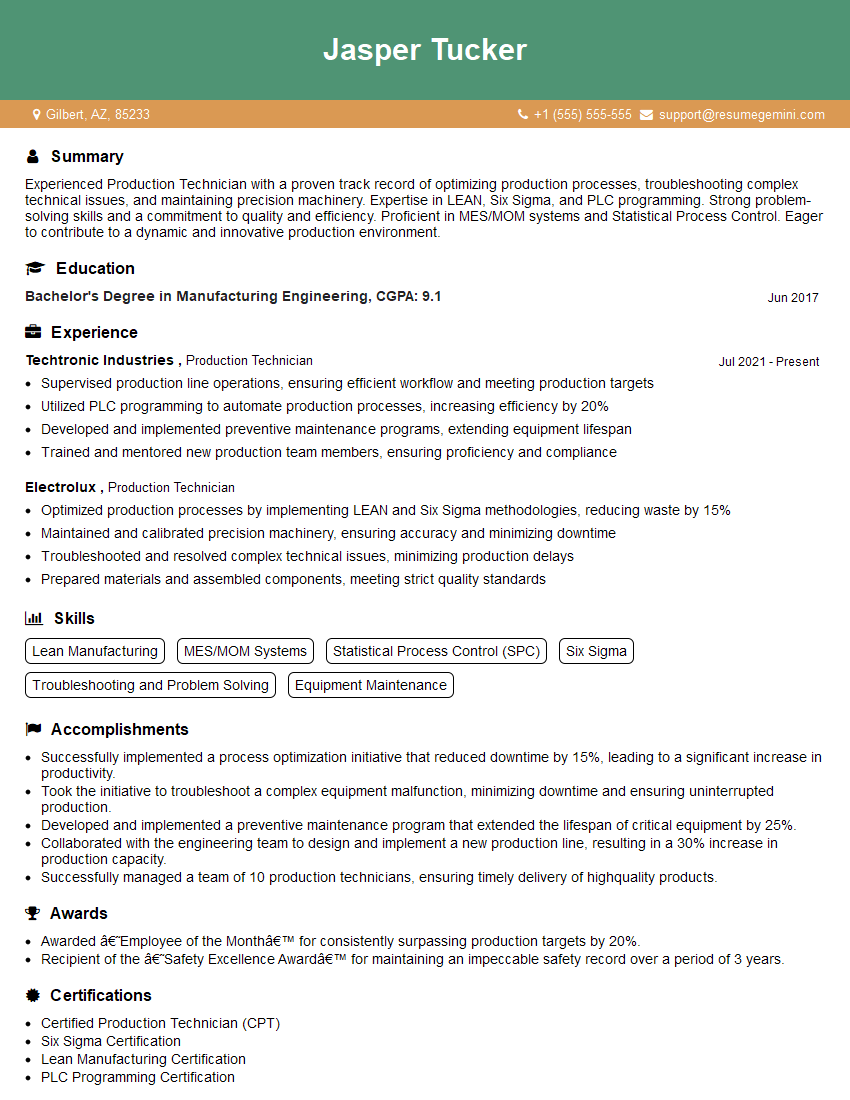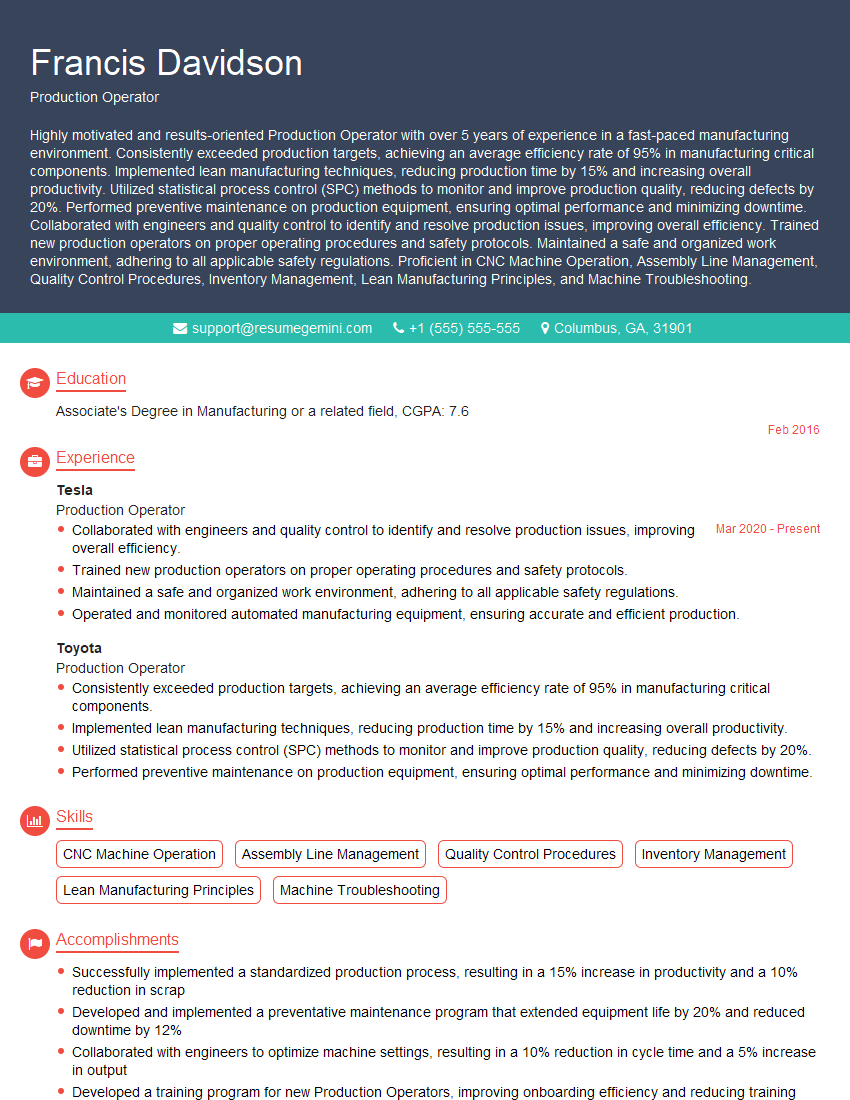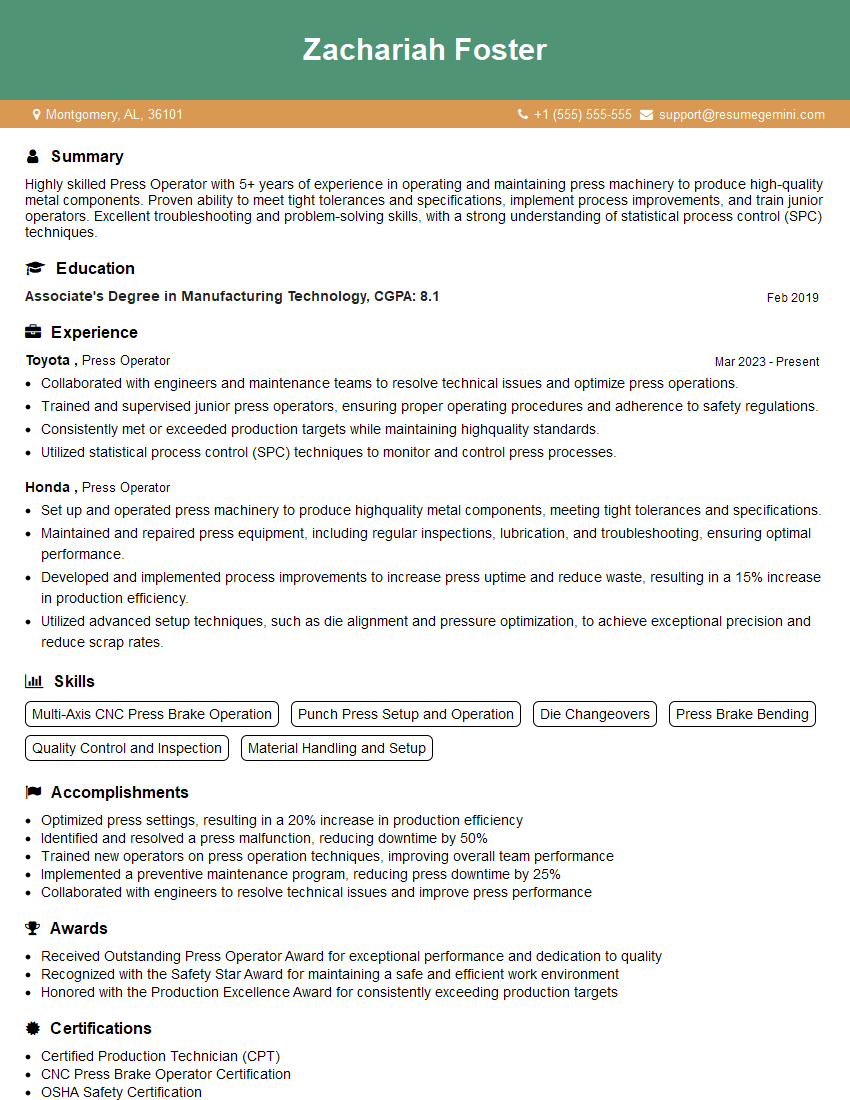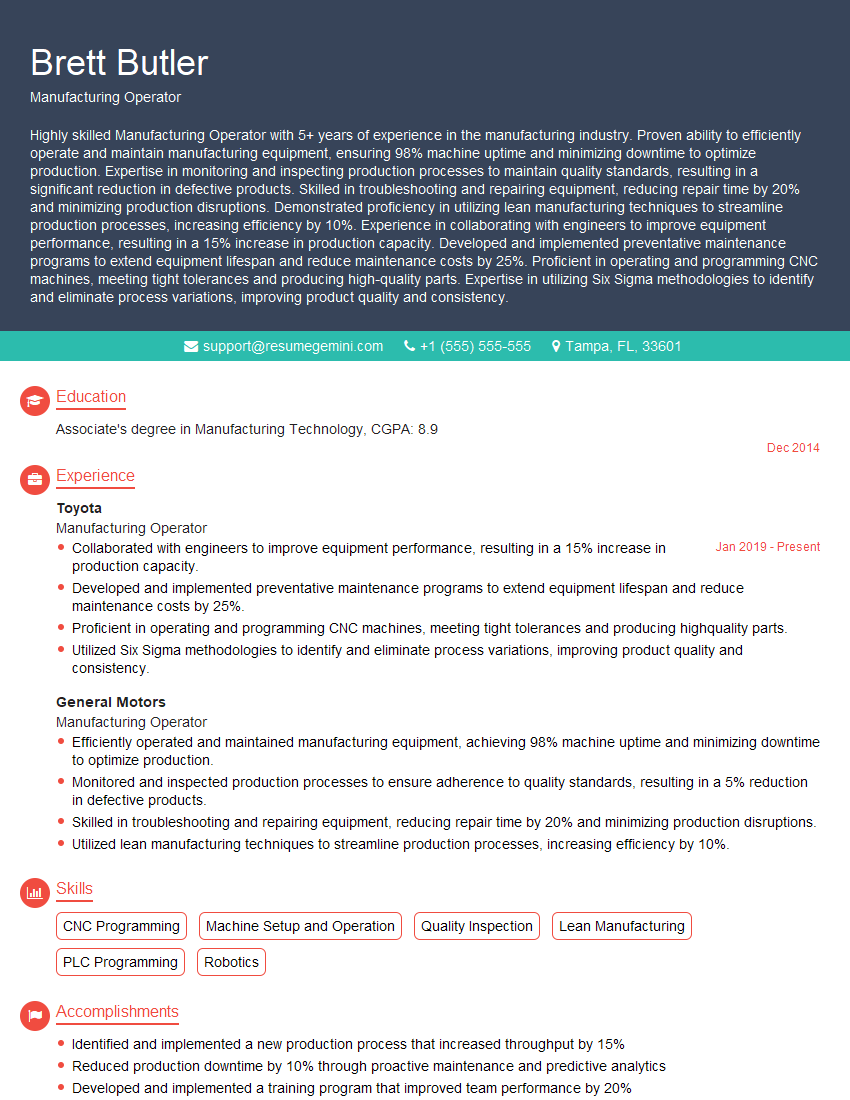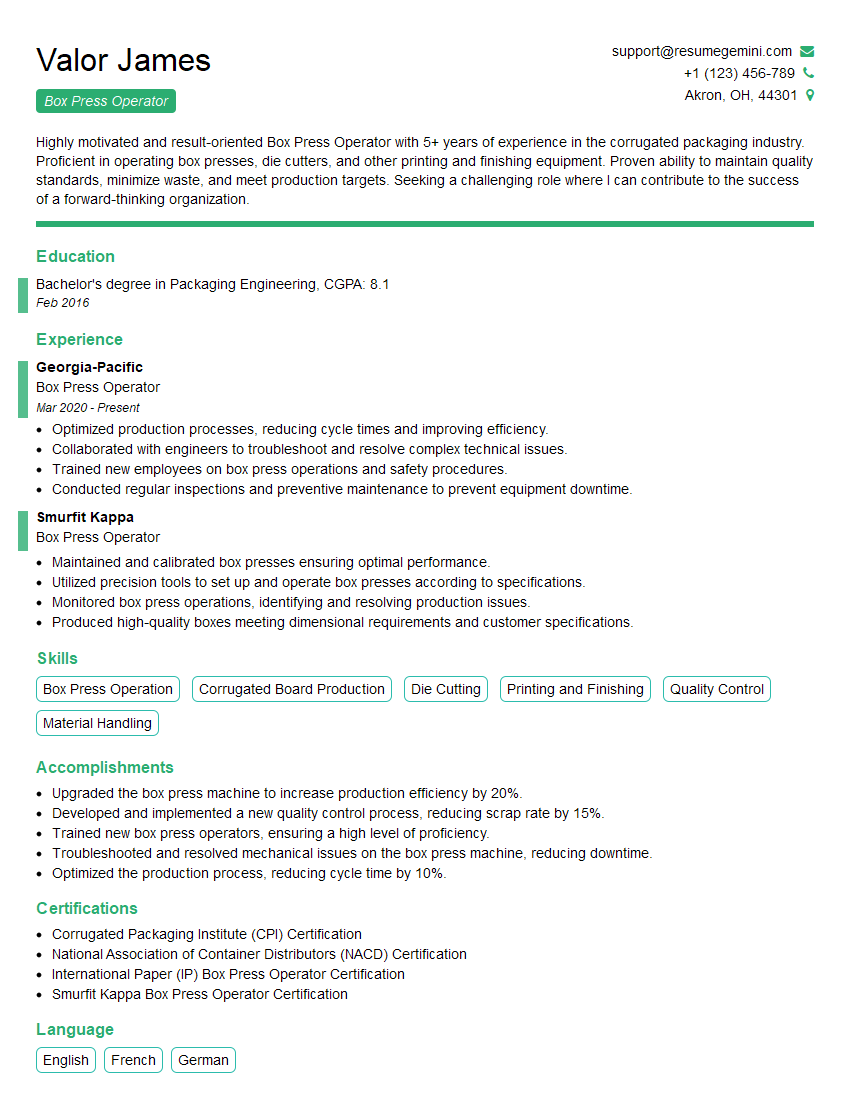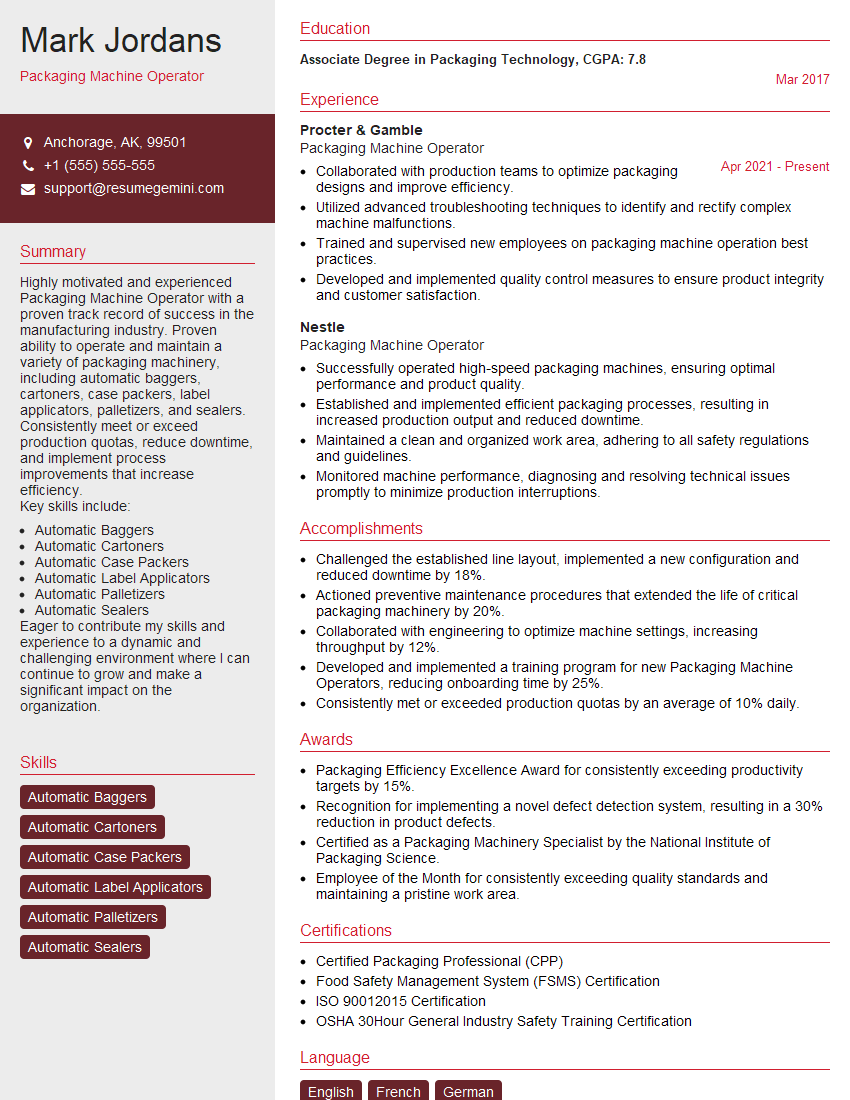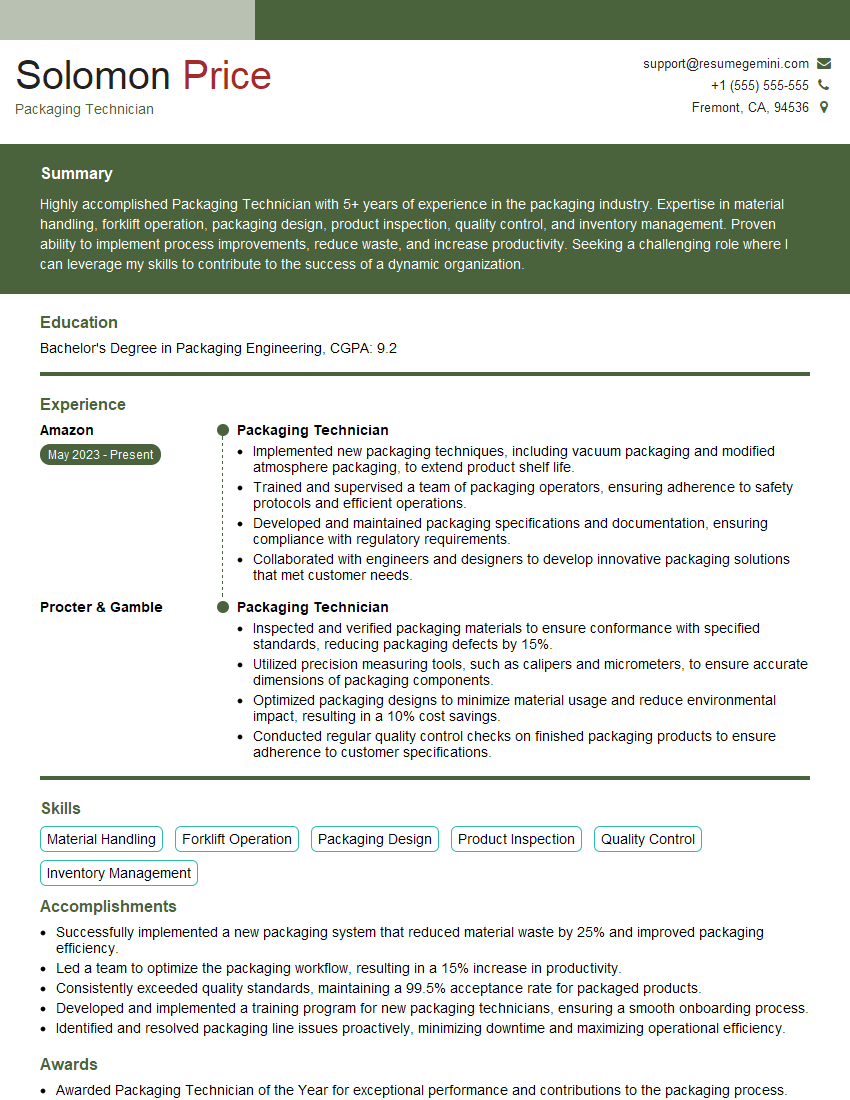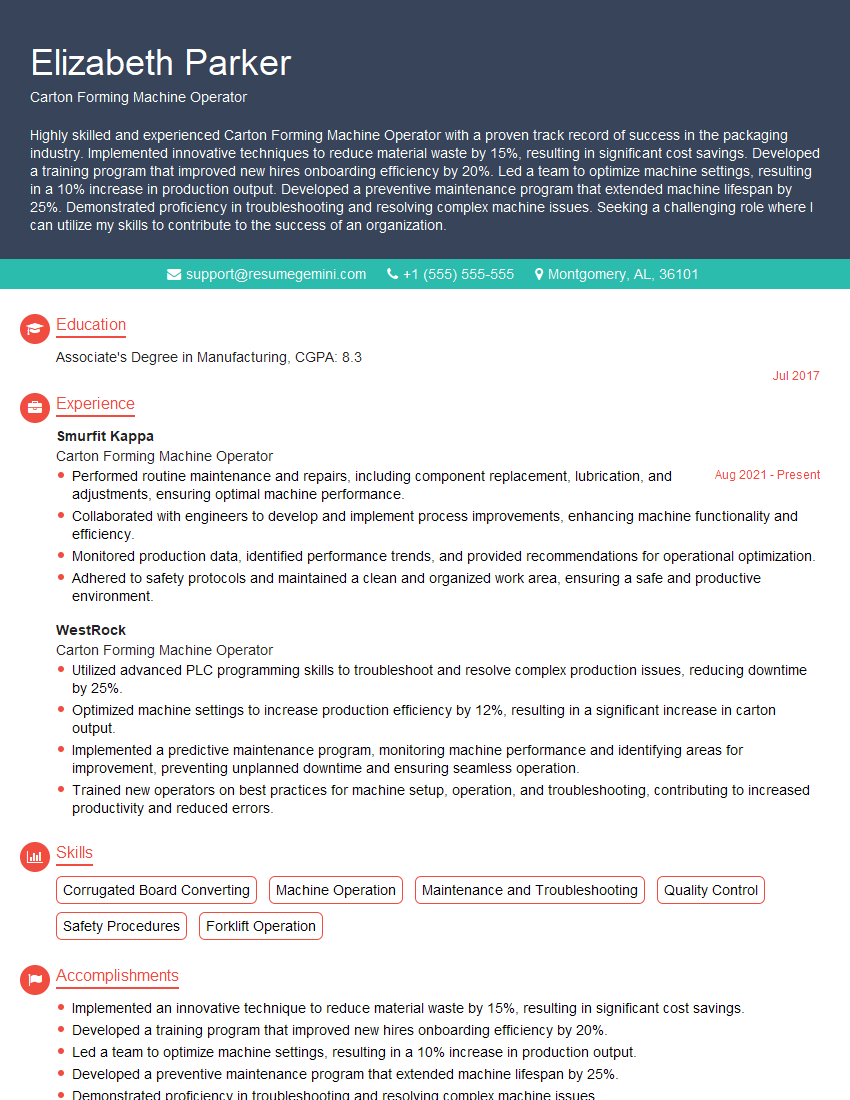Feeling uncertain about what to expect in your upcoming interview? We’ve got you covered! This blog highlights the most important Box Press Operation interview questions and provides actionable advice to help you stand out as the ideal candidate. Let’s pave the way for your success.
Questions Asked in Box Press Operation Interview
Q 1. Describe your experience operating a box press machine.
My experience with box press operation spans over eight years, encompassing various machine types and production environments. I’ve worked in high-volume manufacturing settings, producing millions of boxes annually, and also in smaller, more specialized operations focused on custom box designs. This experience has provided me with a deep understanding of the entire process, from setup and operation to troubleshooting and maintenance. I’m proficient in all aspects, including material handling, die setup, speed adjustments, and quality control. For example, I once managed a team that increased production efficiency by 15% by optimizing the box press settings and implementing a more streamlined material flow.
Q 2. What types of box press machines are you familiar with?
I’m familiar with a range of box press machines, including automatic, semi-automatic, and manual models. This includes:
- Automatic Box Press Machines: These machines automate the entire process, from feeding the blank to the finished box ejection, greatly increasing speed and efficiency. I’ve worked extensively with machines from leading manufacturers, utilizing PLC controls for precise operation.
- Semi-Automatic Box Press Machines: These machines require some manual intervention, typically for loading or unloading materials. They offer a balance between automation and cost-effectiveness.
- Manual Box Press Machines: These are simpler, hand-operated machines suitable for small-scale operations or specialized tasks. While less efficient, they are ideal for low-volume, custom work.
My experience also covers different press types, such as those using straight-line or rotary mechanisms, each with its unique setup and operational characteristics.
Q 3. Explain the setup process for a box press machine.
Setting up a box press machine is a multi-step process requiring precision and attention to detail. It starts with:
- Die Installation: Carefully installing the correct die set for the desired box size and style is crucial. This involves ensuring proper alignment and clamping to prevent misalignment or damage during operation. Incorrect die setup is a common source of errors.
- Material Loading: Feeding the machine with appropriate quality cardboard or corrugated board is essential. The material should be properly aligned and free from defects to avoid jams.
- Machine Adjustments: This includes adjusting settings like pressing force, speed, and timing based on the material type and box design. Precise adjustments are crucial for consistent quality.
- Safety Checks: A thorough inspection of the machine’s safety features (guards, emergency stops) is mandatory before initiating operation.
- Test Run: A small test run allows for fine-tuning of settings and identifying any potential issues before full-scale production.
Imagine setting up a complex stage play – every piece needs to be in the right place and working harmoniously for a flawless performance. The setup process of a box press is similarly meticulous.
Q 4. How do you ensure the quality of the boxes produced?
Quality control is paramount in box press operations. I ensure quality by implementing several key strategies:
- Regular Inspections: Frequent visual checks of the boxes for proper folding, creasing, and dimensions are conducted throughout the production run.
- Dimensional Measurement: Utilizing precision measuring tools to verify that the boxes meet specifications is crucial. Consistent dimensions are vital for packaging integrity.
- Statistical Process Control (SPC): Implementing SPC techniques allows for tracking key quality metrics and identifying any trends that may indicate a developing issue before it becomes significant.
- Material Quality Control: Ensuring the incoming material meets the required specifications. Any defects in the cardboard will directly impact the quality of the finished boxes.
Quality control is not an afterthought; it’s an integral part of the entire production process. My experience includes establishing and maintaining quality control procedures that reduced defects by over 20% in a previous role.
Q 5. What are the common causes of jams or malfunctions in a box press?
Jams and malfunctions in box press machines are often caused by:
- Material Issues: Defective or improperly fed cardboard blanks are a primary cause of jams. This can include damaged cardboard, incorrect dimensions, or improper alignment.
- Die Problems: Worn-out or misaligned dies can lead to inconsistent folding and jamming. Regular inspection and maintenance are crucial.
- Mechanical Failures: Issues like worn bearings, broken belts, or malfunctioning pneumatic components can disrupt operation.
- Electrical Malfunctions: Problems in the control system, sensor failures, or power supply issues can cause malfunctions.
- Incorrect Settings: Improperly set parameters, such as pressing force or speed, can cause the machine to jam or produce defective boxes.
Troubleshooting involves systematic checks to isolate the root cause, which is often a combination of factors. A proactive approach, involving regular maintenance, is critical in preventing many of these issues.
Q 6. How do you troubleshoot common problems with a box press machine?
Troubleshooting involves a systematic approach:
- Safety First: Always ensure the machine is powered off and locked out before attempting any repairs.
- Visual Inspection: Start with a thorough visual inspection of the machine, looking for obvious signs of damage, misalignment, or obstructions.
- Check the Material: Inspect the cardboard for defects, ensuring proper feeding and alignment.
- Examine the Die: Carefully check the die set for wear, damage, or misalignment.
- Review Machine Settings: Verify that all parameters are correctly set according to the specifications.
- Check Pneumatic and Electrical Systems: If necessary, investigate pneumatic components for leaks or malfunctions and inspect electrical systems for loose connections or faulty components.
- Consult Maintenance Manuals: Refer to the machine’s maintenance manuals for detailed troubleshooting guides and diagrams.
I’ve developed a troubleshooting flowchart to streamline this process, dramatically reducing downtime in past roles. A systematic approach helps avoid guesswork and ensures rapid resolution.
Q 7. Describe your experience with preventative maintenance on a box press.
Preventative maintenance is crucial for ensuring the longevity and efficient operation of a box press. My experience includes:
- Regular Lubrication: Regular lubrication of moving parts prevents wear and tear, extending the life of the machine.
- Die Cleaning and Inspection: Regular cleaning and inspection of the dies remove debris and identify potential wear or damage.
- Belt and Bearing Checks: Regular checks of belts and bearings help identify wear and prevent sudden failures.
- Electrical System Checks: Regular checks of electrical connections, sensors, and controls prevent electrical malfunctions.
- Scheduled Maintenance: Establishing a schedule for preventative maintenance ensures that critical tasks are performed regularly.
A well-maintained box press is like a finely tuned engine – it runs smoothly, efficiently, and reliably. Preventative maintenance minimizes downtime and maximizes productivity, ultimately saving time and resources.
Q 8. What safety procedures do you follow when operating a box press?
Safety is paramount when operating a box press. My routine begins with a thorough machine inspection, checking for loose parts, proper lubrication, and ensuring all safety guards are securely in place. I always wear appropriate personal protective equipment (PPE), including safety glasses, hearing protection, and gloves. Before starting any operation, I ensure the area around the machine is clear of obstructions and that no one is within the machine’s operating range. During operation, I remain vigilant, monitoring the machine’s performance and immediately stopping the press if any abnormality is detected. Regular maintenance, as scheduled, is crucial to prevent accidents. I also strictly adhere to the company’s lockout/tagout procedures during maintenance or repairs, ensuring the machine is completely de-energized before any work commences. Think of it like flying a plane; checklists and constant vigilance are essential for a safe and productive operation.
Q 9. How do you handle material changes on a box press?
Handling material changes requires a methodical approach. First, I identify the specific characteristics of the new material, such as its thickness, stiffness, and surface texture. This information dictates adjustments to the press settings. For example, thicker cardboard might require a higher pressure setting to ensure proper creasing and cutting, while a more delicate paper stock will need a lower pressure to avoid damage. I would then run a small test batch with the adjusted settings to observe the results and make any necessary fine-tuning. This includes checking for consistent scoring, clean cuts, and proper box formation. Accurate adjustment ensures both product quality and minimizes material waste. One time, we switched to a recycled cardboard, and its slightly inconsistent thickness initially led to some issues. Through careful testing and adjustments, we were able to overcome these, proving the importance of this meticulous approach.
Q 10. What is your experience with different types of cardboard or paper stock?
My experience spans a wide range of cardboard and paper stocks, from lightweight coated paperboards used for premium packaging to heavy-duty corrugated boards for shipping boxes. I’m familiar with various grades, thicknesses, and finishes, each requiring specific press settings to achieve optimal results. I understand the importance of choosing the right material for the intended application. For instance, a thinner board might be suitable for a small cosmetic box, while a thicker corrugated board is essential for protecting fragile items during shipping. The different types of coatings, such as gloss or matte finishes, also affect how the material interacts with the die, impacting pressure adjustments and the overall quality of the finished product. Experience allows me to quickly adapt to the nuances of each material, minimizing setup time and maximizing efficiency.
Q 11. How do you monitor the production rate and efficiency of the box press?
Production rate and efficiency are monitored through a combination of methods. The box press itself often has a built-in counter that tracks the number of boxes produced. This data, coupled with the timing of production runs, allows me to calculate the boxes per minute (BPM) or boxes per hour (BPH). I also monitor material usage to calculate the efficiency of the operation. This means tracking waste, comparing actual output to planned output, and identifying any bottlenecks in the process. Regular checks ensure that the machine is running at optimal speed and minimizing downtime. For instance, if the BPM drops significantly, I investigate potential causes, such as material jams, faulty dies, or machine malfunctions. By consistently monitoring these metrics and taking proactive measures, we ensure that the box press operates at peak efficiency.
Q 12. Explain your understanding of die cutting and its role in box press operation.
Die cutting is a crucial process in box press operation. It involves using a precisely engineered steel rule die to cut, crease, and perforate the cardboard sheet, creating the required shape and features of the box. The die is mounted on the press, and as the material passes through, the die cuts the various components. The accuracy of the die directly affects the quality of the finished box. A poorly designed or damaged die can result in inaccurate cuts, uneven creases, or even damage to the material. My experience includes working with various die types, from simple to complex designs, and understanding the maintenance required to keep them in optimal condition. Regular sharpening and cleaning are key to ensuring consistently accurate cutting. It’s like using a sharp knife versus a dull one; precision is key in achieving high-quality products.
Q 13. How do you adjust the pressure settings on a box press machine?
Pressure adjustment on a box press varies depending on the specific machine, but typically involves adjusting the pressure settings via a dial, lever, or digital interface. The optimal pressure depends on factors like material thickness, die design, and the desired outcome. Too little pressure might result in incomplete creasing or cutting, while too much pressure can lead to material damage or deformation. I start by consulting the machine’s operational manual for recommended settings for the specific material and die being used. Then, I run a test batch and carefully examine the results. I adjust the pressure incrementally based on my observation, ensuring that the process produces consistent, high-quality boxes. It’s a bit like baking; you need to fine-tune the temperature and time to achieve the perfect result. Continuous monitoring and adjustment are essential for maintaining consistency.
Q 14. Describe your experience with different types of box designs and their implications on press operation.
My experience encompasses a broad range of box designs, from simple tuck-top boxes to complex, multi-piece structures with intricate folds and inserts. Each design presents its own unique challenges in terms of press operation. For instance, a box with many intricate folds requires precise die cutting and careful adjustment of the press settings to avoid misalignment or breakage. Boxes with unusual shapes or sizes may need special tooling or modifications to the press setup. Understanding the design’s implications allows me to proactively adjust the machine and process parameters to ensure optimal efficiency and product quality. For example, when working on a unique perfume box with a hinged lid, we had to carefully adjust the pressure to avoid damaging the delicate lid material while still ensuring a clean and precise cut. This highlights the importance of understanding the design in relation to the machine’s capabilities.
Q 15. How do you maintain accurate records of production output and machine downtime?
Maintaining accurate production records and tracking downtime in a box press operation is crucial for efficiency and profitability. We use a multi-pronged approach. Firstly, we implement a robust system, often involving a combination of digital and manual methods. This could include a dedicated software system integrated with the box press machine, automatically recording production cycles, speeds, and any detected malfunctions. Alternatively, or in addition, we might use spreadsheets or dedicated manufacturing execution systems (MES) where operators manually input data at set intervals or after completing a specific production run. These records usually include the number of boxes produced, the time taken, the type of box, and any material used.
Secondly, for downtime, we employ a meticulous system for recording reasons. Each downtime instance is logged with a specific code indicating the cause (e.g., mechanical failure, material shortage, operator intervention). This granular level of detail is vital for identifying patterns and potential improvements. We also use a time-stamping system to precisely record the duration of downtime, contributing to overall efficiency calculations. This data allows us to calculate Overall Equipment Effectiveness (OEE) and continuously optimize the production process.
For example, during a recent project producing custom-sized pizza boxes, our digital system tracked 15,000 boxes produced in 6 hours with minimal downtime (less than 5 minutes total due to minor adjustments). This data, combined with downtime records, showed us our efficiency was exceptionally high, but also pinpointed the need for a specific tooling adjustment to further minimize that already-small downtime.
Career Expert Tips:
- Ace those interviews! Prepare effectively by reviewing the Top 50 Most Common Interview Questions on ResumeGemini.
- Navigate your job search with confidence! Explore a wide range of Career Tips on ResumeGemini. Learn about common challenges and recommendations to overcome them.
- Craft the perfect resume! Master the Art of Resume Writing with ResumeGemini’s guide. Showcase your unique qualifications and achievements effectively.
- Don’t miss out on holiday savings! Build your dream resume with ResumeGemini’s ATS optimized templates.
Q 16. What is your experience with automated box press systems?
I possess extensive experience with automated box press systems, ranging from basic PLC-controlled machines to highly sophisticated systems integrated with automated material handling and quality inspection. My experience encompasses both setup, operation, and troubleshooting of these systems.
In one project, we integrated a robotic arm into a high-speed box press system. This robot handled the feeding of blanks and the stacking of finished boxes, significantly increasing throughput and reducing labor costs. My role included programming the robot’s movements, optimizing its cycle time, and troubleshooting any integration issues with the box press’s control system. We witnessed a 30% increase in production efficiency after implementation, proving the effectiveness of automation in box pressing.
Another project involved the migration from a manual to an automated system. This included careful planning and training of personnel on the new equipment and software. It also highlighted the importance of robust quality control procedures to ensure the automated system produces consistently high-quality boxes. Effective automation requires a holistic approach, considering the entire production workflow.
Q 17. Describe your experience with using different types of tooling in a box press machine.
My experience with various tooling in box press machines is extensive. This includes different types of cutting dies, creasing dies, and scoring dies. The choice of tooling significantly impacts the final product’s quality and production efficiency.
For example, I’ve worked with both rule dies (for simple designs) and more complex dies with multiple cutting and creasing sections for intricate box designs. Steel rule dies are generally durable and versatile, suitable for a wide range of applications. However, I’ve also utilized laser-cut dies for rapid prototyping and smaller runs, offering shorter lead times but potentially compromising on overall lifespan.
The selection of tooling depends on factors like box design complexity, production volume, material type, and budget constraints. Proper maintenance and storage of dies are equally crucial for extending their life and ensuring consistent box production. Regular sharpening and cleaning of cutting dies, for instance, are essential to prevent premature wear and tearing and maintain precision.
Q 18. How do you identify and resolve issues with die alignment and registration?
Die alignment and registration are critical for consistent box production. Misaligned dies result in inaccurate cuts, creases, and overall poor product quality.
Identifying issues involves a systematic approach. We begin with a visual inspection of the completed boxes for inconsistencies. This is followed by a more detailed examination of the die itself. We’d check for any damage, bending, or wear and tear. We then carefully examine the die’s placement and alignment within the press using precision measuring instruments such as dial indicators and calipers. We use alignment pins and shims to correct minor misalignments.
In case of significant misalignment, we might need to re-sharpen or replace parts of the die, or even re-evaluate the die design. The process often involves iterative adjustments, testing, and fine-tuning to achieve precise registration. For example, a misaligned cutting die could lead to inconsistent box sizes, potentially resulting in rejected products. Through careful alignment and registration procedures, we ensure the production of high-quality boxes.
Q 19. Explain your understanding of the different types of scoring and creasing in box press operation.
Scoring and creasing are crucial processes in box press operation, influencing the final box’s foldability and appearance. Scoring creates a partial cut, making the material easier to fold along a specific line without completely severing it, while creasing creates a sharp, defined fold.
We utilize various techniques, including single- and double-score lines, depending on the material thickness and desired fold sharpness. For thicker materials, we often use deeper scores or a combination of scoring and creasing to ensure clean and consistent folds. The depth and sharpness of the score or crease are carefully controlled to prevent tearing or cracking during folding. Different types of scoring and creasing tools (e.g., rotary, flat, or combination tools) can be used, depending on the specific needs of the box design and material. The type of material also impacts the design decisions here; cardboard requires different scoring than corrugated fiberboard.
Incorrect scoring or creasing can lead to poor folding quality, causing the boxes to be weak or unsellable. Therefore, precise control of these processes is vital for optimal results.
Q 20. What are the common safety hazards associated with box press operation, and how do you mitigate them?
Box press operation presents several safety hazards, including moving parts, sharp cutting dies, and heavy materials. We employ rigorous safety measures to mitigate these risks.
We start with comprehensive safety training for all operators, including lockout/tagout procedures for maintenance and adjustments. We use machine guarding to prevent accidental contact with moving parts. Regular maintenance checks ensure the machines are functioning correctly and that safety devices are operational. We also use personal protective equipment (PPE), such as safety glasses, gloves, and hearing protection. Our facility has clearly marked emergency stops, well-lit work areas and a dedicated first aid station. We follow strict protocols for handling sharp tools and heavy materials, and we conduct regular safety audits to identify and address potential hazards proactively. For example, regular inspections of the safety guards on the machine and operator training on their use are essential elements of our approach.
Implementing a comprehensive safety program is not merely a compliance issue; it’s a commitment to our employees’ well-being and creating a safer, more productive work environment.
Q 21. How do you ensure the accurate and efficient use of cutting dies?
Accurate and efficient use of cutting dies is paramount for consistent box production. It involves proper storage, handling, maintenance, and optimization.
We store dies in a clean, organized manner to prevent damage. This may involve specialized racks or cases to protect them from moisture, dust, or accidental damage. Prior to use, we inspect the dies for any damage or wear. During operation, we monitor the cutting pressure and sharpness, making adjustments as needed. Regular sharpening and cleaning of the dies are critical for maintaining cutting accuracy and extending their lifespan. We also employ proper techniques for handling and changing dies to prevent injuries or damage to the equipment.
Optimization involves selecting the right die for the job, considering factors like material thickness, design complexity, and production volume. Using worn or incorrectly chosen dies will impact the production speed and quality.
Q 22. What are your skills in performing routine maintenance, such as cleaning, lubrication, and adjustments?
Routine maintenance is crucial for the longevity and efficiency of a box press. My experience encompasses a thorough understanding of preventative maintenance, including regular cleaning, lubrication, and adjustments. Cleaning involves removing dust, debris, and glue residue from all moving parts, ensuring optimal performance and preventing jams. Lubrication is equally important, using the correct type and amount of lubricant on bearings and moving parts to reduce friction and wear. This extends the life of components and minimizes downtime. Adjustments are regularly performed to ensure proper alignment of the machine components and to fine-tune parameters like cutting pressure and glue application. For example, I regularly check the blade alignment on our Bobst box press to prevent uneven cuts and ensure consistently sized boxes. This proactive approach minimizes breakdowns and maintains consistent product quality.
Q 23. How do you handle unexpected breakdowns or equipment malfunctions?
Unexpected breakdowns are part of the reality of working with machinery. My approach is methodical and prioritizes safety. First, I prioritize safety by immediately shutting down the machine and ensuring the area is secure. Then, I assess the situation, noting any visible damage or unusual sounds. I systematically check the main components, starting with power supply, then moving to the glue system, and finally to the mechanical parts. For example, if the machine stops unexpectedly, I’ll first check the power supply and fuses before investigating other potential causes like a jammed mechanism or sensor failure. Based on my initial assessment, I determine whether I can fix the issue myself or if I need to call in a specialist. If I need to call in a specialist, I provide them with clear and concise information about the malfunction and my findings to facilitate a rapid repair. Good record keeping is essential, and I always document the issue, my troubleshooting steps, and the solution implemented, which aids in preventing similar future occurrences.
Q 24. Describe your experience with quality control checks throughout the box production process.
Quality control is integrated throughout the box production process. From the initial stages of raw material inspection—checking for flaws in the cardboard sheets—to the final inspection of finished boxes, rigorous quality checks are paramount. I employ a multi-stage approach. Firstly, I visually inspect a sample of boxes from each production run for dimensions, print quality, and structural integrity. Secondly, I use calibrated measuring tools to check the dimensions of the boxes to ensure they meet the required specifications. Finally, I perform a strength test to ensure that the boxes can withstand the expected weight and handling during shipping. If defects are identified, the cause is investigated, corrective actions are implemented, and the affected boxes are removed from the production line. The data collected from each quality check is meticulously documented and analyzed to identify trends and implement continuous improvements in the process. This data-driven approach ensures consistent high quality and minimizes waste.
Q 25. How familiar are you with different types of glues and adhesives used in box press machines?
I am familiar with various glues and adhesives used in box press machines, each with specific properties suited to different applications and materials. These include hot melt adhesives, water-based adhesives, and pressure-sensitive adhesives. Hot melt adhesives are widely used for their fast drying time and strong bond, but they require careful temperature control. Water-based adhesives are environmentally friendly and offer good adhesion, although they require a longer drying time. Pressure-sensitive adhesives offer ease of use and immediate bonding but may not be as strong as hot melt. The choice depends on factors such as the type of cardboard, required bond strength, production speed, and environmental concerns. I have experience selecting and troubleshooting issues related to different adhesive types, understanding how their viscosity, application rate, and drying time affect the final box quality and production efficiency. For instance, I can adjust the hot melt glue temperature to compensate for variations in ambient temperature, ensuring consistent glue application.
Q 26. How do you ensure the proper functioning of the glue system in the box press?
Ensuring proper functioning of the glue system is critical for reliable box production. This involves several key steps. First, I regularly check the glue tank levels and replenish as needed. Second, I monitor the glue temperature and viscosity, making adjustments as necessary using the machine’s control panel to maintain optimal application. Third, I inspect the glue application rollers or nozzles for any clogging or wear, cleaning and replacing them as needed. Fourth, I check the glue pressure and flow rate to ensure consistent application across the entire production run. Fifth, I regularly inspect the glue system for any leaks, addressing them promptly to prevent waste and maintain cleanliness. Finally, I document all glue-related actions, including adjustments, replacements, and maintenance performed, for better tracking and proactive maintenance.
Q 27. What is your experience with different types of box finishing operations, such as printing or coating?
My experience extends to various box finishing operations, including printing and coating. I’m familiar with different printing techniques such as flexographic printing, offset printing, and digital printing, each with its own advantages and limitations in terms of cost, speed, and print quality. I understand the importance of proper ink selection and print registration to achieve high-quality results. Coating, typically applied after printing, protects the printed surface, enhances its appearance, and improves its durability. I’ve worked with various coatings, such as aqueous coatings, UV coatings, and varnish, understanding their respective properties and suitability for different applications. Understanding these processes allows me to contribute to quality control, troubleshooting issues related to color consistency, print defects, and coating imperfections. For example, I’ve trouble-shot an issue where inconsistent ink application was affecting print quality by identifying a faulty roller in the printing unit.
Q 28. Describe a time you had to troubleshoot a complex problem on a box press machine. What was your approach?
One time, we experienced a significant reduction in production speed on our box press. The initial diagnosis pointed towards a potential mechanical failure. My approach was to systematically eliminate potential causes. I started by reviewing the machine’s logs and production data to identify the timing of the slowdown. Then, I carefully inspected the mechanical components, paying particular attention to the areas involved in the box-forming process. I discovered that the timing belt driving the folding mechanism was worn and slipping, causing the slowdown. After replacing the belt and verifying the machine’s calibration, the production speed returned to normal. This experience reinforced the importance of a structured troubleshooting approach, starting with data analysis to narrow down possibilities and then systematically checking components. It also highlighted the need for regular preventative maintenance to prevent such issues. Thorough documentation of the issue, my steps, and the solution remains an invaluable reference for future troubleshooting.
Key Topics to Learn for Box Press Operation Interview
- Machine Operation & Maintenance: Understanding the mechanics of box press machines, including setup, operation, troubleshooting common malfunctions, and preventative maintenance procedures.
- Safety Procedures & Regulations: Demonstrating knowledge of all relevant safety protocols, including lockout/tagout procedures, personal protective equipment (PPE) usage, and hazard identification.
- Quality Control & Assurance: Explaining your understanding of quality checks throughout the process, identifying defects, and ensuring adherence to company standards and specifications. This includes understanding statistical process control (SPC) concepts if applicable.
- Production Efficiency & Optimization: Discussing strategies to maximize output while maintaining quality, such as identifying bottlenecks, suggesting improvements to workflow, and understanding production targets and metrics.
- Materials Handling & Storage: Demonstrating knowledge of proper handling techniques for various materials used in box pressing, including storage procedures to prevent damage or spoilage.
- Troubleshooting & Problem-Solving: Highlighting your ability to diagnose and resolve mechanical issues, identify root causes of production problems, and implement effective solutions.
- Teamwork & Communication: Emphasizing your experience working collaboratively within a team environment, communicating effectively with supervisors and colleagues, and contributing to a positive work atmosphere.
- Data Analysis & Reporting: Understanding how to collect, analyze, and interpret production data to identify trends, improve processes, and report key performance indicators (KPIs).
Next Steps
Mastering Box Press Operation opens doors to exciting career advancements within manufacturing and related industries. A strong understanding of these concepts, combined with a well-crafted resume, significantly increases your chances of landing your dream job. Creating an ATS-friendly resume is crucial for getting your application noticed. We highly recommend using ResumeGemini to build a professional and effective resume that showcases your skills and experience in the best possible light. ResumeGemini provides examples of resumes tailored to Box Press Operation to help you craft a compelling application.
Explore more articles
Users Rating of Our Blogs
Share Your Experience
We value your feedback! Please rate our content and share your thoughts (optional).
What Readers Say About Our Blog
good
